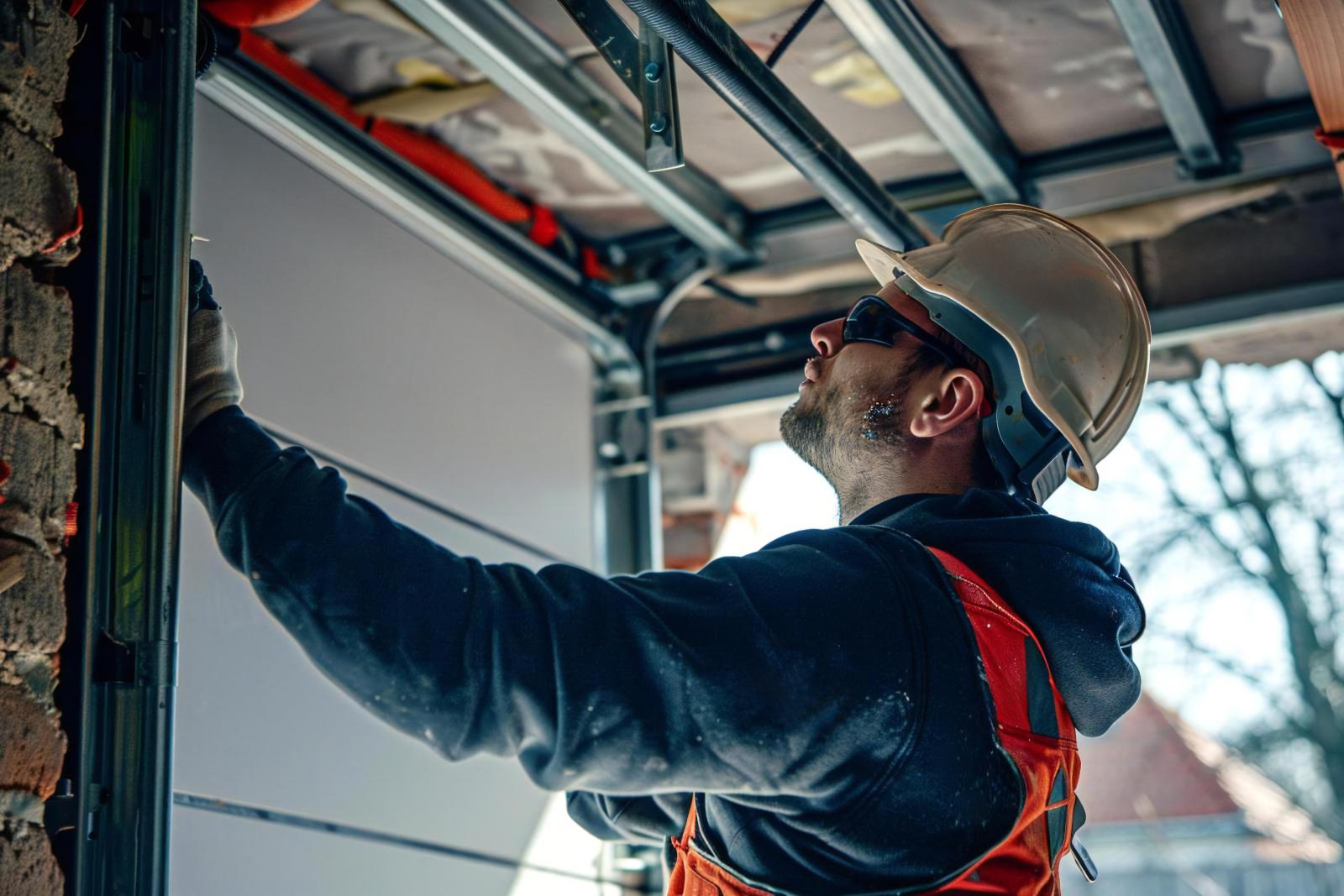Contents
When it comes to getting your garage door installed swiftly and efficiently, you’ll want to keep a few key tips in mind. From measuring the opening accurately to selecting the right door and ensuring proper alignment, each step plays an important role in the process. But what about the critical step of attaching the panels? That’s where attention to detail really matters. Stay tuned to learn how to tackle this aspect effectively and guarantee a smooth installation process from start to finish.
Key Takeaways
- Measure the door opening accurately for a precise fit.
- Select the right door based on material, style, and insulation needs.
- Align and secure tracks and panels correctly for smooth operation.
- Ensure proper installation of springs with safety precautions.
- Test the door thoroughly for balance and safety features post-installation.
Measure the Door Opening
To begin the garage door installation process, measure the opening width and height using a tape measure. Proper measurements are vital for guaranteeing the new door fits perfectly. Start by measuring the width of the opening at the top, middle, and bottom. Record the smallest width to make certain the door will align correctly. Next, measure the height on the left and right sides and at the center. Use the smallest height as the final measurement to prevent any alignment issues.
Consider the door size and clearance requirements when taking measurements. The door size should match the opening dimensions, with some clearance for smooth operation. Typically, standard single-car garage doors are 8-9 feet wide by 7 feet high, while double-car doors range from 16-18 feet wide by 7-8 feet high. Ensure there’s enough headroom above the door opening for tracks and a motor if applicable. Additionally, check for sufficient side room for tracks and springs.
Accurate measurements and alignment are essential for a successful garage door installation. By following these guidelines, you’ll guarantee a smooth process and enjoy a properly functioning garage door that fits perfectly in your space.
Select the Right Door
Consider the style, material, and insulation needs when selecting the right garage door for your installation project. Here are some essential factors to keep in mind:
Material Selection:
The material of your garage door impacts its durability, maintenance needs, and overall appearance. Choose from options like steel for strength, wood for a traditional look, or aluminum for a modern aesthetic.Door Style:
Decide on a door style that complements your home’s architecture and reflects your personal taste. Common styles include traditional raised-panel doors, contemporary flush designs, or carriage house doors for a rustic charm.Color Options:
Select a color that harmonizes with your home’s exterior palette. Whether you prefer classic neutrals like white or beige, bold tones for a pop of color or wood finishes for a natural look, the right hue can enhance your curb appeal.Insulation Choices:
Take into account the climate in your area and how insulation can impact energy efficiency and noise reduction. Opt for doors with added insulation if you use the garage as a living space or want to minimize heat loss in colder months.
Prepare the Opening
Before installing your garage door, it’s essential to clear the space for installation and check for proper alignment. Start by ensuring the opening is free of any obstructions that could hinder the installation process.
Then, double-check that the frame is properly aligned to avoid any issues when fitting the new door.
Clear Space for Installation
Make sure the area where the garage door will be installed is completely clear of any obstructions or debris. This step is essential for a smooth installation process.
Here are some tips to help you prepare the opening for your new garage door:
Remove all items: Clear out any tools, equipment, or storage items from the area where the garage door will be installed.
Sweep and clean: Thoroughly sweep the floor and clean the walls to make certain there’s no dust or dirt that could interfere with the installation.
Check for overhead clearance: Confirm there’s enough vertical space above the opening for the garage door to operate without any obstructions.
Inspect the tracks: Examine the tracks where the door will slide to ensure they’re clear of any debris or objects that could impede the door’s movement.
Check for Proper Alignment
Make sure that the opening where the garage door will be installed is properly aligned to avoid any issues during the installation process. Essential alignment is vital for the smooth operation of your garage door. Start by checking if the opening is square and level. Use a level and measuring tape to confirm that the sides and top of the opening are at right angles. If adjustments are needed, make them before proceeding further.
Next, focus on the track positioning. The vertical tracks on either side of the opening should be plumb and parallel to each other. Use a level to inspect the vertical tracks and adjust them if necessary. The horizontal track sections should slant slightly toward the back of the garage to allow for smooth door movement. Make sure that the tracks are securely fastened to the wall.
Install the Tracks
Now, it’s essential to focus on aligning the tracks correctly for smooth door operation. Make sure to secure the mounting brackets firmly to provide stability for the tracks.
Proper installation of the tracks is vital for the overall functionality and longevity of your garage door system.
Track Alignment
Align the tracks carefully to ensure smooth operation of your garage door. Proper track alignment is vital for the functionality and longevity of your garage door system.
Here are some essential tips to help you align your tracks effectively:
Check Alignment: Use a level to make sure the tracks are straight and plumb. Any misalignment can cause issues with the door’s movement.
Secure Bolts: Make sure all the bolts and screws securing the tracks are tightened. Loose hardware can lead to misalignment over time.
Clear Obstructions: Remove any debris or obstructions from the track that could hinder the door’s movement. Clean tracks ensure smooth operation.
Adjust Track Spacing: Ensure the tracks are parallel and at the same height. Incorrect spacing can cause the door to bind or come off track during operation.
Secure Mounting Brackets
Check the alignment of the mounting brackets before proceeding to install the tracks for your garage door system. Proper bracket placement is vital for guaranteeing the door operates smoothly and maintains balance. Here are some essential tips to securely mount your brackets:
| Bracket Reinforcement | Safety Precautions |
|---|---|
| Reinforce brackets with sturdy screws and bolts | Wear safety goggles and gloves when handling brackets |
| Ensure brackets are firmly attached to the wall | Use a ladder on a stable surface to reach high brackets |
| Double-check bracket alignment before tightening screws | Keep children and pets away from the installation area |
| Use a level to make sure brackets are straight | Test the stability of brackets before hanging the tracks |
| Follow manufacturer guidelines for bracket installation | Avoid over-tightening screws to prevent damage |
Attach the Panels
Attach the panels securely to create a sturdy foundation for your garage door installation. Proper attachment ensures that your door operates smoothly and lasts longer.
Here’s how to effectively attach the panels:
Panel Alignment: Before attaching the panels, make sure they’re aligned correctly to avoid any issues with the door’s movement. Misaligned panels can cause the door to jam or operate noisily. Use a level to ensure precise alignment.
Panel Insulation: If your panels come with insulation, ensure it’s facing the correct way. Insulation helps regulate the temperature inside your garage, making it more energy-efficient. Align the panels carefully to maintain the insulation’s effectiveness.
Secure Fastening: Use the recommended screws or nails to securely fasten the panels together. Loose panels can lead to instability and compromise the door’s integrity. Check the manufacturer’s instructions for the appropriate fastening method.
Even Spacing: Maintain an even spacing between each panel to ensure smooth operation when the door opens and closes. Consistent spacing also enhances the door’s appearance and prevents any rubbing or sticking issues.
Following these steps will help you attach the panels correctly, setting a solid foundation for the rest of your garage door installation.
Install the Springs
To properly complete the garage door installation process, make sure the springs are securely installed for the best functionality. Spring tension is vital for the smooth operation of your garage door. When installing the springs, it’s essential to follow safety precautions to prevent any accidents. Be cautious of the high tension these springs carry, and always use the proper tools and equipment to avoid injuries.
While installing the springs yourself may seem like a cost-saving option, professional installation offers numerous benefits. Professional installers have the expertise and experience to ensure the springs are installed correctly and securely. They can also adjust the tension levels precisely, providing excellent performance for your garage door. Additionally, professional installation can save you time and give you peace of mind, knowing that the job was done right.
When it comes to spring tension, it’s best not to take any risks. Professional installers are trained to handle the intricacies of garage door springs, making them the safest option for installation. By choosing professional installation, you’re investing in the longevity and functionality of your garage door while prioritizing safety above all else.
Test the Door
Assure the proper functioning of your garage door by conducting a thorough test after installing the springs. Testing the door confirms that all components are working correctly and that your installation was successful.
Follow these steps to test your garage door:
Check Balance: Close the door and disconnect the automatic opener. Manually lift the door halfway; it should stay in place. If it falls or rises, the balance needs adjustment.
Inspect Safety Features: Test the auto-reverse feature by placing an object in the door’s path as it closes. The door should reverse immediately upon contact with the object. Also, ensure that the photo-eye sensors are aligned correctly.
Test Opening and Closing: Operate the door using the automatic opener. Check for smooth and quiet operation. If you notice any jerking or unusual noises, further adjustments may be necessary.
Verify Manual Operation: In case of a power outage, test the manual operation of the door. Pull the emergency release cord and lift the door manually to ensure it moves freely.
Remember to follow safety precautions during the testing process, such as keeping hands and objects clear of the door’s moving parts.
If you encounter any issues during testing, consider seeking professional assistance to address them promptly and assure the safety and functionality of your garage door.
Recap
Now that you’ve followed these seven easy tips for a quick garage door installation, you’re practically a pro!
Remember to measure accurately, choose the right door, prepare the opening, install the tracks, attach the panels, secure the springs, and test thoroughly.
With these steps, you’ll have your new garage door up and running in no time – it’s as easy as pie!




